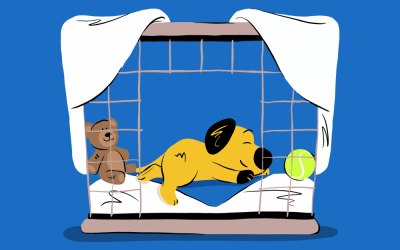Why Dogs Sigh: Calm, Frustrated, or Something Else?

Just like us, dogs have their own unique ways of expressing their emotions. While tail wags and excited barks are easy to recognize, some signals, like a gentle sigh, can be a bit more subtle. You might hear your pup let out a soft exhale as they curl up on the couch or gaze you after a long walk. But what does it really mean when a dog sighs?
Let’s explore the reasons behind this often-overlooked behavior and what it could be telling you about your dog’s mood and needs.
A Sigh of Contentment
One of the most common—and comforting—reasons your dog might sigh is simple relaxation. After an energetic play session or a nice meal, that deep exhale often signals that your pup feels safe, calm, and content. If your dog stretches out on their bed, lets out a sigh, and settles in, it’s usually a sweet sign that everything feels just right in their world.
Sometimes, It’s a Gentle Ask for Attention
Dogs are social by nature and love being around their humans. If your pup sighs while looking at you or resting nearby, they might just be nudging you for a little attention. It’s their polite way of saying, “Hey, I’m here if you want to hang out.”
These sighs are often paired with soft eye contact, nudging, or even a gentle paw tap. If you have the time, a quick belly rub or play session can go a long way in showing them you’re listening.
Sighs That Come from Disappointment or Boredom
Unfortunately, not all sighs are happy ones. If your dog was hoping for a walk or treat that didn’t happen, a sigh might be their version of a disappointed sigh, just like we might let one out when our plans fall through.
If your dog sighs frequently throughout the day and appears restless or disinterested, they may require additional mental stimulation. Try rotating toys, introducing new games, or even teaching a new trick to keep things engaging.
What If Your Dog Sighs a Lot?
Hearing your dog sigh often isn’t always cause for concern. Some dogs are simply more vocal or expressive than others. That said, it’s always a good idea to pay attention to the bigger picture.
If those sighs are happening alongside signs of discomfort—like limping, whining, or low energy—it’s worth checking in with your vet. A quick visit can help rule out anything physical and give you peace of mind.
Understanding the Context Makes All the Difference
A dog’s sigh means different things depending on what’s happening around them. Think about what they were doing just before the sigh—were they playing, eating, relaxing, or watching you move around the house?
- Relaxed sighs often follow activity and are accompanied by a calm body and soft eyes.
- Bored sighs might show up during periods of inactivity, when your dog is looking for a little excitement or interaction.
- Uncomfortable sighs can be accompanied by pacing, stiffness, or other changes in behavior.
Reading your dog’s body language and considering the setting helps you respond in a way that supports their well-being.
Sighing When They Lie Down? That’s Usually a Good Sign
You’ve probably noticed your dog letting out a sigh as they flop down for a nap. That sound often means they’re winding down, releasing tension, and feeling safe.
This is especially true after a long walk or busy day—think of it as your pup’s version of a cozy exhale before bed. If the sigh is followed by dozing off or relaxed breathing, it’s likely a positive signal.
If, however, your dog seems uncomfortable when lying down or shifts around restlessly after sighing, check their bed for comfort and watch for any signs of pain or unease.
Sighing While Being Petted? That Can Be a Sweet Sign Too
Many dogs let out a happy sigh while being stroked or scratched, especially in their favorite spots. This usually signals trust, affection, and enjoyment. It’s their way of saying, “Ahhh, that’s the spot.”
But every dog is different. If your pup sighs and then shifts away or seems uninterested, they might just be signaling they’ve had enough for now, and that’s okay, too. Respecting those cues helps strengthen the bond between you.
Other Sounds Your Dog Might Make—and What They Mean
Sighs aren’t the only vocalizations dogs use to communicate. Being familiar with their sounds helps you respond more mindfully:
- Whining: Can signal anxiety, excitement, or a need, like wanting to go outside.
- Barking: A catch-all vocalization that can mean anything from “I’m excited” to “Stranger alert!”
- Growling: Usually a warning to back off. Respect it—your dog’s trying to tell you something important.
- Howling: Might be their way of communicating loneliness, or just joining in on sounds they hear.



